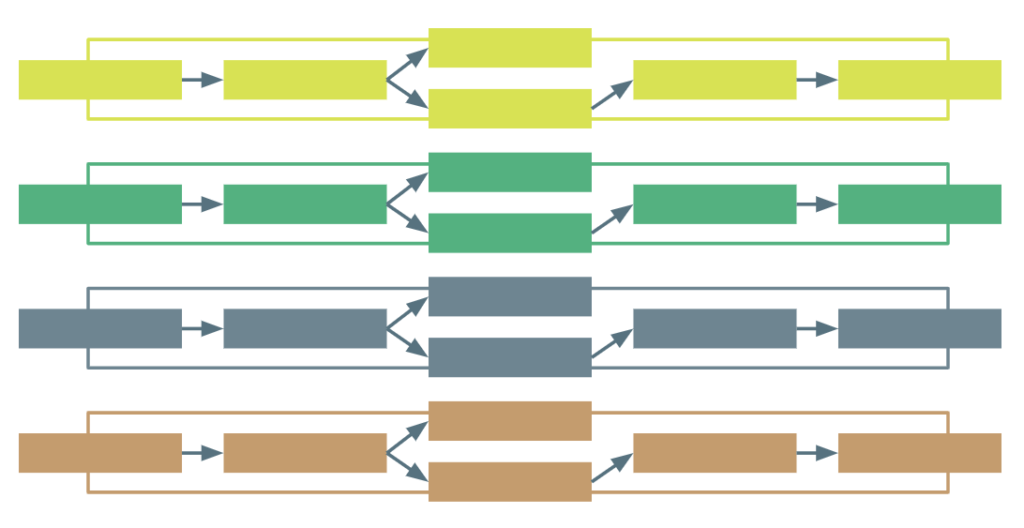This post has been brewing in my head for over a year already and it’s finally ready to come out. This post is also the result of experiences built up over the last 5 years, working at and with companies such as TrendMiner, OSIsoft, SoftwareAG, VersaSense, and today at Rombit. It’ll start with some observations, it’ll end in a rant 🙂
On solving customer value first
If you are in any form of Product Management these days, you’ll know to focus on solving the customer need first. Start at the end and work your way back towards the solution.
A solution provider that is solving a specific customer need within the IoT space today will usually offer this with all the components of the data-flow chart below. In the old days, we’d argue there’s only “one throat to choke“. Today we call it an End-2-End Solution.

On two separate value chains
However, whilst talking to a lot of customers in the field, I’ve noticed a discrepancy in this model where there are two value chains for the customer.
They either have an application in mind or already in place, but do not have enough (reliable) data. So they are looking for an IoT Solution Enabler. Or they don’t really care that much about how the data is generated since they assume sensors and hardware is cheap. So they are looking for an IoT Enabled Solution.

Beyond the Early Adopters
Today we are moving beyond the early adopters of I(I)oT, slowly heading into the early majority*. But this also means that the early adopters are facing the next challenge. They now end up with a myriad of End-2-End solutions, all with their own device management and data management flow.

Integrating data between the solutions is not the priority of the solution builder so all they will do is give you an API. And handing over the device management to a 3-rd party is not something they are very fond of either (quite rightfully so …).
*: reference to Crossing the Chasm
In come the Platforms!
In come the (IoT) platform players. These are the players that ‘could’ make it possible to integrate all these IoT Solution Enablers with the IoT Enabled Solutions. Bringing it from a 1-to-1 to N-to-N matrix. Exponential value! Whoot whoot ….

The reality, however, is NOT this … The IoT Platforms players are all trying to focus on building and owning the solutions, rather than enabling them. In my opinion, this is incredibly short-sighted and shows they have no confidence in becoming the one platform to rule them all.
Secondly, you’ll notice I put the device management in light blue. This was on purpose! The fact that all these End-2-End solutions are building their own device management layers is because there is a clear lack of industry standards! And it’s the laziness of the platforms that this is a fact!
Device Management (for IoT)
I know it’s not easy finding an industry standard for device management within the IoT Platform space. I mean; Microsoft does have an Iot Hub Device Management but there’s not a lot happening there. And if you go into the other IoT Platforms, you’ll see very lightweight device management (why do you think they all use smartphones as a demo?).
What needs to be part of device management?
- Multi-Tenant Asset Framework
- INSTALLATION
- Deploy
- Configure
- MAINTENANCE
- Update/Upgrade & Roll-back
- (re)Calibrate
- Monitor & Troubleshoot
- RUN
- Deploy Applications
On the other hand, most of End-2-End solutions we talked about earlier usually have all of this hard-coded from scratch. Particle built something like this for their platforms, but that doesn’t help for other players. Balena is an Open-Source platform but quite limited to off-the-shelf Operating Systems (think RapberryPi/Intel/NVidia). Looking at all this from a WarldleyMApping perspective, they are spending a lot of resources on components that are too far away from the user needs!
Key Takeways
THE IoT PLATFORMS NEED TO FOCUS ON ENABLING THE HARDWARE PLAYERS and THE SOLUTION PLAYERS. YOU ARE THE INTEGRATORS!
AND LEAVE THE RIGHT SIDE OF THE EQUATION TO THE SUBJECT MATTER EXPERTS !!!

I just read your article and I found it very enlightening and informative. Thank you for sharing such valuable insights. I would also like to extend an invitation to you to visit my website Perangkat IoT and we can collaborate with each other.
warm regard.
My pleasure! Since it’s been a while that I wrote down these views, would you say I was heading in the right direction? Do you feel it played out this way or do you have different/additional insights?